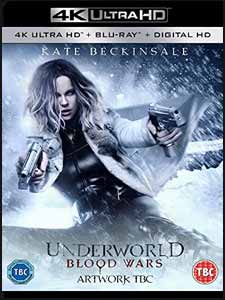|
Click here to return to the main site. James McQuaide (VFX) - Underworld: Blood Wars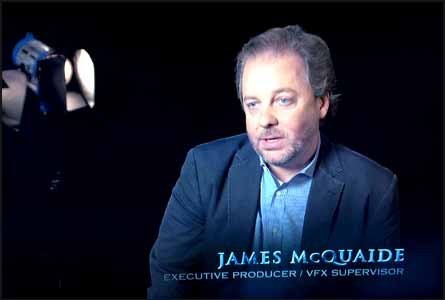 James McQuaide acted as executive producer and visual effects (VFX) supervisor on the fifth Underworld movie, Blood Wars. It's a franchise he's been involved with from the first movie back in 2003. Outside of Underworld he was the VFX for movies including The Age of Adaline (2015), as well as executive producer and VFX producer on The Vatican Tapes (2015) and I, Frankenstein (2014). Darren Rea spoke with him about the use of VFX in the latest Underworld film... Darren Rea: With a movie like Underworld: Blood Wars how far before principal photography commences are you brought on board?
Originally we started the film with a great sequence with Selene jumping on a train to meet David, the Theo James character. And a big fight ensues, with lycans on the train... That's what the original script was. So we sat for 6-8 weeks planning this pretty darn cool sequence, and ultimately [laughs] the studio changed the idea for the opening to the motorcycle sequence that you see now. We spent a year going through the sequences, talking about the characters and every director that comes on has a different asthetic which needs to meld with the formula we used with Kate that came before it. So it's working with her to understand what she's looking for and making it work with the other Underworlds: with the mythology with the aesthetics, all of which takes a bit of time. With audiences, especially of a franchise like Underworld, having seen so many visual effects is there a constant pressure to do something new? With every Underworld picture we always introduce a new character. That always brings its own particular challenges.
Lycans, for the most part, are just rapid dogs, as they say at the beginning of the first Underworld film. They don't really have a lot of personality. Here we had a character that needed a practical actor that would eventually become a CG creature. That was something we've delivered on every picture which always brings us new challenges. The asthetic of the whole franchise has been to try to make them invisible. We occasionally do a showy effect, like David cutting the Lycan in half, but for the most part we try to stay in the background to support the story. With the first picture Len Wiseman [director] really wanted to veer quite significantly to the practical. That's why we had the guys in the suits. It's kind of interesting to watch the Underworld franchise as it's run parallel to the development of digital effects. With Underworld I, CGI creatures were few and far between, we did a couple but they were done as afterthoughts. We were deep in post and really had no option, for some of the ideas we had, but to fall back on CG creatures. As the digital technology has gotten better and the artist are more used to doing creature work, we've begun to move more into the digital realm.
On the Blu-ray disc you're interviewed in one of the extras and you point out how many CGI lycans you had transforming on screen in a couple of scenes. Watching the movie I was so caught up in the story that those scenes didn't stick out as obvious CG moments - which I guess was the idea. One of the scenes I loved was the attack on the vampires, where they're disintegrating. There's one scene where a vampire is turning to dust but his gun is still waving around... To be honest, that may be my favourite shot in the whole movie. That was not planned. It wasn't prevised or boarded. It wasn't even scripted. When they shot that, and they caught that bit of action, you knew right away that was too great a shot to let go. They did a really brilliant job. They did all the disintegration effects. It's quite beautiful to look at, the way he's sort of burning up from inside is quite impressive. Very much like you, I love that shot quite a bit.
I've done shows where I've worked on shots that I thought were quite good but the reason that they don't necessarily work as well as they could is that the sequence or the scene around them isn't as strong as it could be. That's why for Underworld 5 the year prior to production was spent designing these sequences so that when we had a big showy shot, like 100 plus lycans transforming, it didn't feel like it wasn't supported by the sequence around it. It blends in. It's cool but it doesn't bring attention to itself. With sequences like that, how much creativity are the animators allowed or is everything tightly scripted? A lot of these sequences really don't match the script. We take the script as a basis for the story or at least the general idea of the sequence and then we develop it in previs quiet extensively. In postvis we take the plates that were shot and sometimes we steal a plate that had nothing to do with the postvis idea we have, and really develop the sequences from that point on. That said, the previs/postvis process really works in broad strokes. It doesn't have the other tools to do the stuff that makes these shots work, so we give the postvis - and obviously talk about it quite a bit - to the various companies that work on the picture. But the artists are the ones that bring the magic to the screen. They take the idea and really bring it alive and add little details that make the shot work quite well. Is there ever enough time or money?
We really don't start the effect shots until the picture is locked or really close to locked, which means that in the case of Underworld 5 we had to turn around 650 shots in 12 weeks. We simply couldn't start until we knew exactly what we had to do and so as a result we threw nothing away and every cent is on the screen. But by the same token we had to push everyone really hard to get the quality of work and number of shots through the pipeline in about 3 months, which is quite fast. Is there any sequence you wish you'd had more time on? Anything that niggles you when you watch it now, even though nobody else will even notice?
If I could do it over again I'd go back, take another couple of weeks to really develop the power and shoot plates that support and make sure that all those plates are photographed. Knowing how much work you were going to have on the effects side did being Executive Producer as well help that process? I've executive produced all five of the movies, second unit directed a bunch of them, what's great about it is you have a lot more creative input and of course the authority to follow through with that creative input. What you get in post and what you do in post, you have a little more free reign than you might otherwise if you were just the VFX supervisor on the picture. Having these titles, I think, streamlines what I'm able to do and allows for the kind of input I like to have. I was reading an article recently in which scientists debated the theory that we may be currently living in a virtual reality world, similar to The Matrix. While it sounds like merely sci-fi, how long do you think it will be before the technology is available to create a digital version of Earth that is indistinguishable from the real thing?
Technology has moved on pretty quickly in such a short space of time. It's now almost possible to create a CG character that you could believe is real... The last shot in the picture when we see [spoiler removed]. That was all CG. The actor wasn't available. That was really the first time I did that. They're relatively close in the shot, which got cut a little bit to make it work with the music, but the full shot is pretty remarkable. It was done pretty quickly without much to base it on but the result is pretty effective. Do you remember the first visual effects that blew you away when you were growing up? When I was a little kid I remember Sunday afternoon watching the Sinbad movies with the Ray Harryhausen stop motion effects. Sure, technically it has its problems but it's so charming and more effective in many ways than photo real effects these days. There's a life to those animations which is very effective even still. Of all the effects you've been involved with in your career is there one you're most proud of?
Can you tell us what you're currently working on? I'm working on a picture called Axl which is basically about a boy and his dog, but the dog happens to be a robot dog that escaped a military installation. It's about their relationship and of course the military is trying to get the dog back. It's an interesting picture because the director's aesthetic is much more like a Larry Clark movie or Harmony Korine movie, it's very real. The kid's in the picture are in their late teens and then you introduce into that aesthetic this robot dog, which doesn't belong. It's like mixing genres, like mixing Terrence Malick like photo documentary with ET. The mix up is quite effective.
We worked with Legacy Effects who built a full scale puppet which is really quite brilliant and that's effective for close ups and scenes with the actors interacting. But then we have other shots where the creature's running around or wider shots where the puppet wouldn't do at all, so that falls into the CG realm. The challenge is to create a performance with the movement of the dog and make the audience fall in love with the dog like ET or Lassie - make it feel real and really empathetic.
Underworld: Blood Wars is out now on Blu-ray, DVD and Digital Download. Click here to buy this 4K Ultra HD Blu-ray - Amazon.co.uk Return to... |
|---|
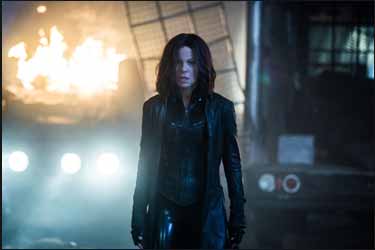 James McQuaide: I am heavily involved with the previs on these pictures, so I would have come on a year before to start work with the director on prevising sequences. Part of it is for budgetary reasons: trying to figure out how to make these sequences work within the money we think we have to work with a year out.
James McQuaide: I am heavily involved with the previs on these pictures, so I would have come on a year before to start work with the director on prevising sequences. Part of it is for budgetary reasons: trying to figure out how to make these sequences work within the money we think we have to work with a year out. 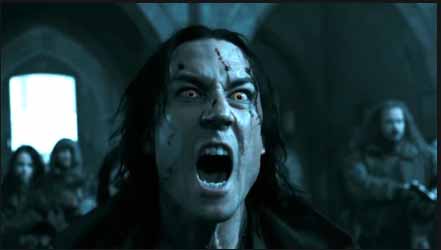 The Marius hybrid creature obviously need to look, act and move like the actor, but then be eight feet tall and so the challenge in this picture was to try to make the Marius creature not only look like the actor but also be a real character.
The Marius hybrid creature obviously need to look, act and move like the actor, but then be eight feet tall and so the challenge in this picture was to try to make the Marius creature not only look like the actor but also be a real character. 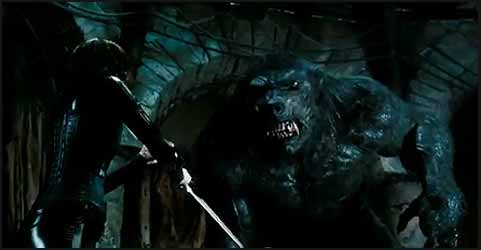 With Blood Wars we went into the picture trying to use the suits - we had a couple of suits. The guys did a great job but in this day and age the ability to move and express are done much better in the digital realm than they can ever be done by suits. So, the trick with the picture is to try to ensure that those digital effects look at least as good as the suits, if not better, and maintain that practical asthetic in the pictures.
With Blood Wars we went into the picture trying to use the suits - we had a couple of suits. The guys did a great job but in this day and age the ability to move and express are done much better in the digital realm than they can ever be done by suits. So, the trick with the picture is to try to ensure that those digital effects look at least as good as the suits, if not better, and maintain that practical asthetic in the pictures.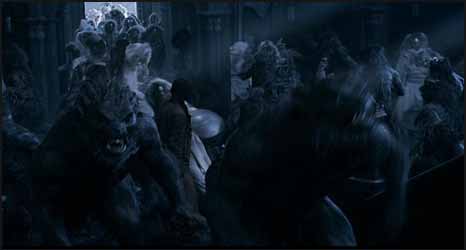 The mass transformation shot was a real challenge. In the past we've done two or three lycans transforming but never anything quite on the scale of this and obviously there's some technical concerns about making that shot work but I think it comes down to, again, designing sequences where it's appropriate to have that kind of transformation.
The mass transformation shot was a real challenge. In the past we've done two or three lycans transforming but never anything quite on the scale of this and obviously there's some technical concerns about making that shot work but I think it comes down to, again, designing sequences where it's appropriate to have that kind of transformation.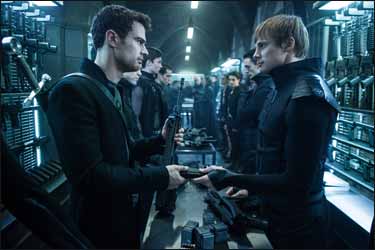 [Laughs] No. Never. You know, these movies are relatively low budget pictures. The first Underworld movie was made for $17M or something [the budget is reported to be $22M - Ed]. We're not a lot more than that on Underworld 5 [$35M - Ed]. My VFX budget is 1/15 of what a The Guardians of the Galaxy kinda picture is, yet you're competing in the same arena. The audience expect the same kind of experience in the theatre. The difficult thing is to put every cent of that on the screen and on a typical movie you start a bunch of shots early and if they don't end up in the picture then you throw them away, and there's no harm done to the budget, but I don't have that kind of latitude.
[Laughs] No. Never. You know, these movies are relatively low budget pictures. The first Underworld movie was made for $17M or something [the budget is reported to be $22M - Ed]. We're not a lot more than that on Underworld 5 [$35M - Ed]. My VFX budget is 1/15 of what a The Guardians of the Galaxy kinda picture is, yet you're competing in the same arena. The audience expect the same kind of experience in the theatre. The difficult thing is to put every cent of that on the screen and on a typical movie you start a bunch of shots early and if they don't end up in the picture then you throw them away, and there's no harm done to the budget, but I don't have that kind of latitude. 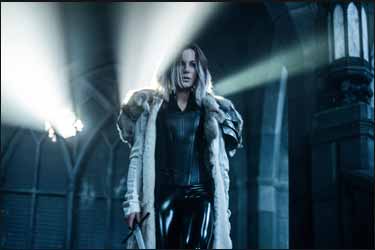 The thing that we tried and didn't quite reach the level we were shooting for, was the Selene "Flash-like" movement; the way she can move quickly through things in sort of a big motion blur. It was an idea that came late in the script writing processes. It's a tricky power: why doesn't she use it all the time? It's also a power you could do quite cool things with. We developed it in the eleventh hour and we were quite deep into production. We didn't quite shoot all the plates we needed and the net result is it works, I think, in the story but it's not nearly as cool as what we envisioned.
The thing that we tried and didn't quite reach the level we were shooting for, was the Selene "Flash-like" movement; the way she can move quickly through things in sort of a big motion blur. It was an idea that came late in the script writing processes. It's a tricky power: why doesn't she use it all the time? It's also a power you could do quite cool things with. We developed it in the eleventh hour and we were quite deep into production. We didn't quite shoot all the plates we needed and the net result is it works, I think, in the story but it's not nearly as cool as what we envisioned.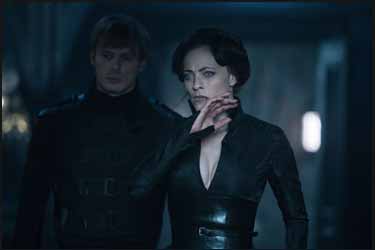 That's not my ream of expertise by any means. I don't know how to answer that question. Hopefully in our lifetime that would be fun to see...
That's not my ream of expertise by any means. I don't know how to answer that question. Hopefully in our lifetime that would be fun to see...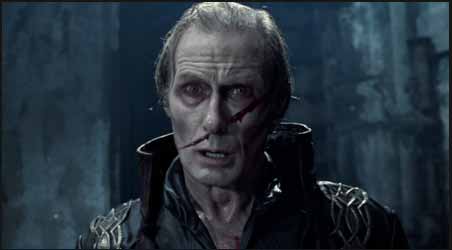 That's a tough question. Maybe it wasn't the most technically complicated of the shots I've worked on, but I think in many ways Vicktor's death in the first Underworld film. Selene basically cuts his head in half and it's revealed on her sword that there's blood there, so she's clearly made contact with his head. She looks back and the top half of Vicktor's head slowly slides off his body and the body then falls forward. But to watch that shot with an audience was such a pleasure because everyone screamed and hollered because they loved how Vicktor had died. Not the most complicated shot technically, but narratively and just as a piece of eye candy, it is the most effective shot I've ever done and the one I like the best.
That's a tough question. Maybe it wasn't the most technically complicated of the shots I've worked on, but I think in many ways Vicktor's death in the first Underworld film. Selene basically cuts his head in half and it's revealed on her sword that there's blood there, so she's clearly made contact with his head. She looks back and the top half of Vicktor's head slowly slides off his body and the body then falls forward. But to watch that shot with an audience was such a pleasure because everyone screamed and hollered because they loved how Vicktor had died. Not the most complicated shot technically, but narratively and just as a piece of eye candy, it is the most effective shot I've ever done and the one I like the best.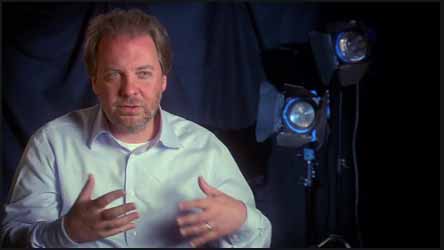 It's an interesting picture too. The robot dog's name is Axl and is really, in many ways, the star of the picture so from a visual effects perspective you need to create a performance with the CG robot dog.
It's an interesting picture too. The robot dog's name is Axl and is really, in many ways, the star of the picture so from a visual effects perspective you need to create a performance with the CG robot dog. 